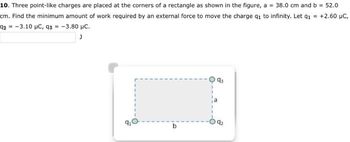Question

Transcribed Image Text:10. Three point-like charges are placed at the corners of a rectangle as shown in the figure, a = 38.0 cm and b = 52.0
cm. Find the minimum amount of work required by an external force to move the charge q1 to infinity. Let q₁ = +2.60 µC,
92-3.10 µC, 93 = -3.80 μC.
J
91
1
93
92
Expert Solution
This question has been solved!
Explore an expertly crafted, step-by-step solution for a thorough understanding of key concepts.
This is a popular solution
Trending nowThis is a popular solution!
Step by stepSolved in 3 steps with 2 images

Knowledge Booster
Similar questions
- Two point charges Q1 -80.0 µC and Q2 20.0 µC are separated by a distance d1 = 10.0 cm, as shown in the image. Calculate the potential at point A positioned d2 = 4.00 cm to the left of Q1. Аarrow_forwardThe work done by an external force to move a -8.60 μC charge from point a to point b is 1.90x10-³ J. Part A If the charge was started from rest and had 4.77x10-4 J of kinetic energy when it reached point b, what must be the potential difference between a and b? ——| ΑΣΦ Vb - V₂ = ? Varrow_forwardTwo identical point charges (q = +1.00 x 10-6 C) are fixed at opposite corners of a square whose sides have a length of 0.420 m. A test charge (90 = -7.50 × 10-8 C), with a mass of 2.80 x 10-8 kg, is released from rest at one of the corners of the square. Determine the speed of the test charge when it reaches the center of the square. Number i Units .90 VBarrow_forward
- Problem 13: Each plate of a parallel-plate capacitor has an area of A = 0.61 m2. The plate separation is 3.0 mm, and one of these plates is shown in the figure. It carries a charge of Q = 2.9 μC, which is concentrated on its inner surface. Imagine a cylindrical Gaussian surface, of radius r = 0.012 m, whose axis is perpendicular to the plates. One end of the cylinder is inside the plate shown and the other end is located between the plates. Both ends are parallel to the plates. Part (a) What is the flux through surface 1 Φ1, in newton meters squared per coulomb? Part (b) What is the flux through surface 2 (the outside of the cylinder not including the ends), in newton meters squared per coulomb? Part (c) What is the flux through surface 3 Φ3, in newton meters squared per coulomb? Part (d) Using all of your results, input an expression for the field within the capacitor E, in terms of the quantities given in the problem.arrow_forward5. Three point-like charges are placed at the corners of a rectangle as shown in the figure, a = 38.0 cm and b = 48.0 cm. q2 = +3.30 μC, Find the work done by the electric field force when the charge q2 is moved to infinity. Let q₁ = -2.50 µC, 93 = +3.60 μC. J f60 ssf60 s too s ai 91 ssf60 ssf60 ssf60 ssf60 ssf60 ssfóð 09js (9) 09.19js (9js (9jss 93 ssf60 ssss$60 ssf60 sst ssf6092 oss is mos f60 ssf60 ssf60 ssf60 ssf60 ssf60 50 ssf60 ssf60 ssfarrow_forwardA point charge of 1.0 x 10-9 C is located at the origin. How much work is required to bring a positive charge of 5.0 x 10-9 C from infinity to the location x = 30.0 cm? Jarrow_forward
arrow_back_ios
arrow_forward_ios